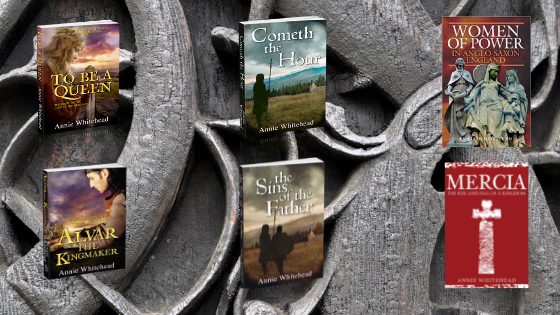Locations
I spend nearly all my time writing, be it novels, books, stories, or blog posts, but this year I emerged blinking and nervous into the outside world to talk - yes, out loud! - about my beloved Anglo-Saxons.
Many of my posts this year concerned trips to Anglo-Saxon locations. My first post of the year here on the blog detailed my visit to Repton, a research trip for the new book. There, I saw the Anglo-Saxon crypt and the remains of the archaeological dig which revealed so much about the Viking occupation of Repton in the 870s. (Read the post HERE)
and then I wrote about another trip, this time exploring the locations involved with the battle of Heavenfield, in Northumbria (Click HERE)
Another location post, this time from the royal site of Yeavering (LINK) was followed by one showing one of the earliest surviving Anglo-Saxon churches, at Escomb (LINK).
Blog Articles
Gearing up to send my new book to the publisher, I posted an article about the 'evil' women of Mercia. Were they really evil though? Find out HERE
Meanwhile I mused about how we can hear and get to know characters from the past, as we reach across the centuries during research. Here's the LINK
This was followed by a post about Anglo-Saxon food - what they ate, and what they called it. Read the post HERE
I then posted an article detailing what we know about Anglo-Saxon childhood, (see the article HERE) and I mused on the recorded deaths of leading Anglo-Saxons and how they rarely seemed to die of their wounds (LINK) After that came a post about captive nuns, and how women weren't always necessarily safe. Read about these women HERE
Out and About
One of the undoubted highlights of my year was the invitation to speak at the Tamworth Literary Festival about how I fictionalised the life of the Lady of the Mercians. Not only did I have a lovely time talking about one of my favourite people and chatting to the folk who attended the talk, I also met the lady herself! Here's the transcript of my TALK
In October, I was invited by the Garstang Historical Society to talk about Anglo-Saxon Attitudes, and you can read the transcript of my talk HERE
I was honoured to be asked by Staffordshire Live about my opinion of the portrayal of Æthelflæd in the Netflix Series The Last Kingdom. You can read the interview HERE
Book News
For the 1100th anniversary of the death of the Lady of the Mercians, and to coincide with the commemorations, the wonderful Cathy Helms of Avalon Graphics gave To Be A Queen a brand new cover:
I also now have a website dedicated to my books and stories, and you can find it here: anniewhiteheadauthor.co.uk
And of course, 2018 saw the publication by Amberley Books of my first full-length nonfiction book Mercia: The Rise and Fall of a Kingdom which I'm thrilled to say reached #1 in its category on Amazon and has remained in the top 20 and frequently in the top 10 ever since. It has also earned a Discovering Diamonds award and was short-listed for their Book of the Month. (Award review HERE)
The reviews have been very positive:
Tony Riches - The Writing Desk
History: The Interesting Bits
Adventures in Historyland
Faith, Fiction, Friends
(which also recommended it as nonfiction book of the year! Here)
The book was also reviewed by History of War Magazine:
I'm also delighted to be able to say that I am currently hard at work on my new book for Pen & Sword Publications, focusing on the women of Anglo-Saxon England, which will be published in late 2019/early 2020.
Other Blog Appearances
Research Roadblocks: Historical Writers' Association
Research - Fiction Vs Nonfiction: Deborah Swift
King Cenwulf: History the Interesting Bits
Mercian Locations: Amberley Blog
Bringing Characters to Life: Women Writers
I'd like to thank everyone who reads my blog posts and wish you all a very Happy Christmas and a peaceful New Year.
Before I leave you, please do read an enjoy this short story. It's not historical, there's not an Anglo-Saxon in sight, but it was good fun to write! Song Behind the Story














